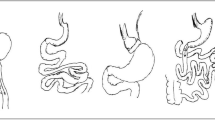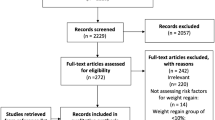Abstract
Background
Significant and sustained excess weight loss (EWL) appears to reduce the risk of obesity-related comorbidities (insulin resistance, hyperlipidemia, and inflammation), but this has been primarily shown in adult diabetic obese patients. We evaluated whether the EWL obtained 3 years after laparoscopic adjustable gastric banding (LAGB) improves the metabolic phenotype in nondiabetic morbidly obese (NDMO) individuals from south Italy.
Methods
Serum and subcutaneous adipose tissue (SAT) samples from 20 obese individuals (median BMI = 41.5 kg/m2) before (T0) and after LAGB (T1) and from 10 controls (median BMI = 22.8 kg/m2) were taken. Serum leptin, adiponectin, C reactive protein (CRP), and main analyte levels were evaluated by routine methods or immunoassay. In SAT, adipocyte size was measured by hematoxylin/eosin staining, cluster of differentiation 68 (CD68) macrophage infiltration marker by immunohistochemistry, and adiponectin, adiponectin receptors 1 and 2, and interleukin 6 (IL6) messenger RNAs by qRT-PCR.
Results
The average EWL was 66.7 %, and CRP, triglycerides, hepatic markers, leptin levels, homeostasis model assessment, and the leptin/adiponectin ratio were lower (p < 0.05) at T1 than at T0. The expression of small adipocytes and adiponectin was increased (p < 0.05), and inflammation markers (CD68 and IL6) decreased (p < 0.05) at T1 vs. T0. At linear regression multivariate analysis, over 90 % (R 2 = 0.905) of EWL (dependent variable) was explained by CD68, adiponectinemia, triglyceridemia, CRP, and total protein levels.
Conclusions
The EWL obtained 3 years after LAGB resulted in an improvement of lipid metabolism and a reduction of inflammation in NDMO patients, thereby decreasing the risk of obesity-associated diseases.



Similar content being viewed by others
References
Johnson AR, Milner JJ, Makowski L. The inflammation highway: metabolism accelerates inflammatory traffic in obesity. Immunol Rev. 2012;249(1):218–38. doi:10.1111/j.1600-065X.2012.01151.x.
Leal VO, Mafra D. Adipokines in obesity. Clin Chim Acta. 2013;419:87–94. doi:10.1016/j.cca.2013.02.003.
Mc Tigue KM, Hess R, Ziouras J. Obesity in older adults: a systematic review of the evidence for diagnosis and treatment. Obesity (Silver Spring). 2006;14(9):1485–97.
O’Brien PE, MacDonald L, Anderson M, et al. Long-term outcomes after bariatric surgery: fifteen-year follow-up of adjustable gastric banding and a systematic review of the bariatric surgical literature. Ann. Surg. Jan;257(1):87–94. doi:10.1097/SLA.0b013e31827b6c02.
Campos GM, Rabl C, Roll GR, et al. Better weight loss, resolution of diabetes, and quality of life for laparoscopic gastric bypass vs banding: results of a 2-cohort pair-matched study. Arch Surg. 2011;146(2):149–55. doi:10.1001/archsurg.2010.316.
Favretti F, Segato G, Ashton D, et al. Laparoscopic adjustable gastric banding in 1,791 consecutive obese patients: 12-year results. Obes Surg. 2007;17(2):168–75.
Pilone V, Mozzi E, Schettino AM, et al. Improvement in health-related quality of life in first year after laparoscopic adjustable gastric banding. Surg Obes Relat Dis. 2012;8(3):260–8. doi:10.1016/j.soard.2011.12.012.
Dixon JB, Chuang LM, Chong K, et al. Predicting the glycemic response to gastric bypass surgery in patients with type 2 diabetes. Diabetes Care. 2013;36:20–6.
Cobourn C, Chapman MA, Ali A, et al. Five-year weight loss experience of outpatients receiving laparoscopic adjustable gastric band surgery. Obes Surg. 2013;36(1):20–6. doi:10.2337/dc12-0779.
Bonora E, Kiechl S, Willeit J, et al. Prevalence of insulin resistance in metabolic disorders: the Bruneck study. Diabetes. 1998;47(10):1643–9.
Labruna G, Pasanisi F, Nardelli C, et al. High leptin/adiponectin ratio and serum triglycerides are associated with an “at-risk” phenotype in young severely obese patients. Obesity (Silver Spring). 2011;19(7):1492–6. doi:10.1038/oby.2010.309.
Labruna G, Pasanisi F, Nardelli C, et al. UCP1–3826 AG + GG genotypes, adiponectin, and leptin/adiponectin ratio in severe obesity. J Endocrinol Investig. 2009;32(6):525–9. doi:10.3275/6108.
Norata GD, Raselli S, Grigore L, et al. Leptin: adiponectin ratio is an independent predictor of intima media thickness of the common carotid artery. Stroke. 2007;38(10):2844–6.
Faraj M, Havel PJ, Phelis S, et al. Plasma acylation-stimulating protein, adiponectin, leptin, and ghrelin before and after weight loss induced by gastric bypass surgery in morbidly obese subjects. J Clin Endocrinol Metab. 2003;88(4):1594–602.
Trakhtenbroit MA, Leichman JG, Algahim MF, et al. Body weight, insulin resistance, and serum adipokine levels 2 years after 2 types of bariatric surgery. Am J Med. May;122(5):435–42. doi:10.1016/j.amjmed.2008.10.035.
Knerr I, Herzog D, Rauh M, et al. Leptin and ghrelin expression in adipose tissues and serum levels in gastric banding patients. Eur J Clin Investig. 2006;36(6):389–94.
Moschen AR, Molnar C, Geiger S, et al. Anti-inflammatory effects of excessive weight loss: potent suppression of adipose interleukin 6 and tumour necrosis factor alpha expression. Gut. 2010;59(9):1259–64. doi:10.1136/gut.2010.214577.
Bjursell M, Ahnmark A, Bohlooly YM, et al. Opposing effects of adiponectin receptors 1 and 2 on energy metabolism. Diabetes. 2007;56(3):583–93.
Yamauchi T, Nio Y, Maki T, et al. Targeted disruption of ADIPO-R1 and ADIPO-R2 causes abrogation of adiponectin binding and metabolic actions. Nat Med. 2007;13(3):332–9.
Illán-Gómez F, Gonzálvez-Ortega M, Orea-Soler I, et al. Obesity and inflammation: change in adiponectin, C-reactive protein, tumour necrosis factor-alpha and interleukin-6 after bariatric surgery. Obes Surg. 2012;22(6):950–5. doi:10.1007/s11695-012-0643-y.
Conroy R, Lee EJ, Jean A, et al. Effect of laparoscopic adjustable gastric banding on metabolic syndrome and its risk factors in morbidly obese adolescents. J Obes. 2011;2011:906384. doi:10.1155/2011/906384.
Buchwald H, Avidor Y, Braunwald E, et al. Bariatric surgery: a systematic review and meta-analysis. JAMA. 2004;292(14):1724–37.
Dixon JB, O’Brien PE, Playfair J, et al. Adjustable gastric banding and conventional therapy for type 2 diabetes: a randomized controlled trial. JAMA. 2008;299(3):316–23. doi:10.1001/jama.299.3.316.
Holterman AX, Browne A, Dillard 3rd BE, et al. Short-term outcome in the first 10 morbidly obese adolescent patients in the FDA-approved trial for laparoscopic adjustable gastric banding. J Pediatr Gastroenterol Nutr. 2007;45(4):465–73.
Varady KA, Tussing L, Bhutani S, et al. Degree of weight loss required to improve adipokine concentrations and decrease fat cell size in severely obese women. Metabolism. 2009;58(8):1096–101. doi:10.1016/j.metabol.2009.04.010.
Cancello R, Henegar C, Viguerie N, et al. Reduction of macrophage infiltration and chemoattractant gene expression changes in white adipose tissue of morbidly obese subjects after surgery-induced weight loss. Diabetes. 2005;54(8):2277–86.
Acknowledgments
We thank Jean Ann Gilder (Scientific Communication srl, Naples, Italy) for revising and editing the manuscript. Grants from CEINGE Regione Campania (DGRC 1901/2009), IRCCS Fondazione SDN, Ministry of Health, POR Campania FSE 2007-2013-CUP B25B09000050007, PRIN 2008, Project CREME, and Project PON02_00619_3461281 are acknowledged.
Conflict of Interest
The authors declare no conflicts of interest.
Author information
Authors and Affiliations
Corresponding author
Additional information
Laura Iaffaldano and Carmela Nardelli contributed equally to this paper.
Rights and permissions
About this article
Cite this article
Iaffaldano, L., Nardelli, C., Pilone, V. et al. Laparoscopic Adjustable Gastric Banding Reduces Subcutaneous Adipose Tissue and Blood Inflammation in Nondiabetic Morbidly Obese Individuals. OBES SURG 24, 2161–2168 (2014). https://doi.org/10.1007/s11695-014-1326-7
Published:
Issue Date:
DOI: https://doi.org/10.1007/s11695-014-1326-7




